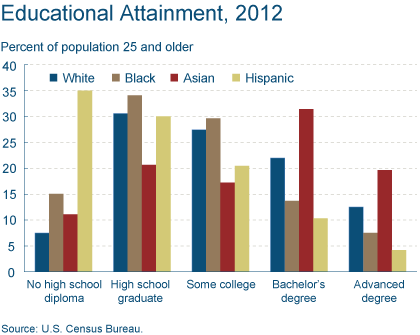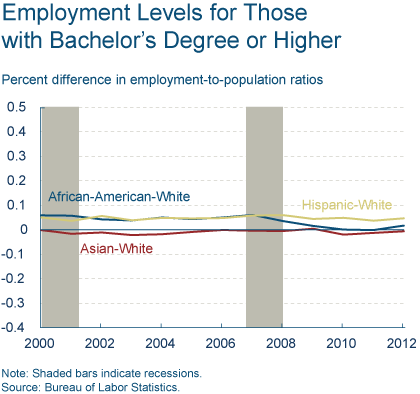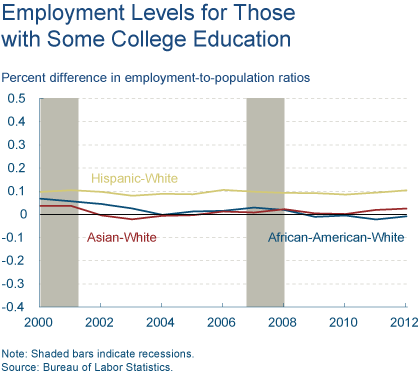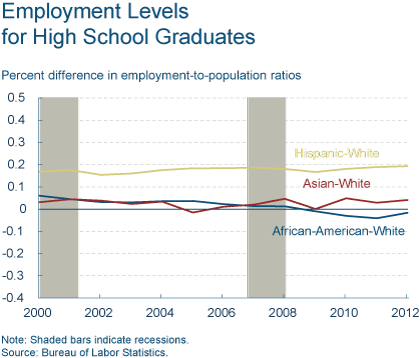Educational Attainment and Demographic Differences in Employment
It is well known that employment outcomes such as unemployment rates and employment-to-population ratios vary markedly across demographic groups. Differences in unemployment rates are especially pronounced across age and racial groups. For example, in January 2013 the unemployment rate for African Americans was approximately double that of whites.
Unemployment Rate in January 2013 (percent, seasonally adjusted)
| All | Gender | Age | Race | Ethnicity | |||||||
|---|---|---|---|---|---|---|---|---|---|---|---|
| Male | Female | 16-24 | 25-34 | 35-44 | 45-54 | 55+ | White | African American | Asian | Hispanic | |
| 7.9 | 8.0 | 7.8 | 16.8 | 7.7 | 6.5 | 6.0 | 6.0 | 7.0 | 13.8 | 6.3 | 9.7 |
It is also well-known that employment outcomes depend significantly on educational attainment, and that levels of educational attainment vary across race and ethnicity. For example, in 2012, 35 percent of Hispanics had not completed high school, compared with 8 percent of whites. (Note that Hispanic represents an ethnic category, so that both African-American and white racial categories include some Hispanics, while the Hispanic group contains individuals who identify as neither African American nor white.)

We examine recent data on employment-to-population ratios and find that although educational attainment explains much about labor market outcomes by race and ethnicity, it does not explain everything. We look at the percent differences in these ratios for three groups relative to whites, compared at the same level of educational attainment. (A value of zero means the ratios are identical, positive values mean a group has a higher ratio than whites, and negative values the opposite.) We find that differences in labor market outcomes across race and ethnic groups remain even at similar levels of educational attainment. Whites and Asians have very similar employment ratios at all levels of educational attainment, Hispanics have much higher employment ratios of African Americans has declined at the top and low ends of educational attainment.
Between 2000 and 2007, Hispanics and African Americans with bachelor's degrees (BAs) were more likely to be employed than whites. The Great Recession has had an uneven effect on these racial patterns. We can see a clear shift down, for instance, in the employment of African-American BA holders relative to white BA holders since the Great Recession began. While these figures have been annualized, it appears that African Americans and white BA holders are now employed at more similar rates than before the recession.

For those with some college, Hispanics also have a higher overall employment-to-population ratio than whites. (Some college includes associates degrees, technical or professional accreditation, one or more college courses, etc.) African Americans with some college tended to be employed more on average over the period leading up to the recent recession.

The relative employment of African Americans with high school diplomas to whites with high school diplomas seems to have undergone a sustained decline since 2000, and this decline appears to only have been accelerated by the Great Recession. In 2000, the employment-to-population ratio of African American high school graduates was 6 percent higher than for whites, and by 2011 this figure had fallen to 4 percent less than whites.

Meanwhile, African American high school dropouts were 16 percent less likely to be employed than white high school dropouts in 2000, and this ratio has been further declining since then. The long-run decline appears to have only been accelerated by the recent recession. Hispanic high school dropouts have also undergone a long-run decline in their employment ratio relative to whites since 2000. This decline, however, does not appear to have been strongly influenced by either the 2001 recession or the Great Recession. Though the employment-to-population ratios of Asians and whites are very similar in each educational category, the difference between the two is greatest for high school dropouts.
If educational attainment alone determined employment, then whites and Hispanics would have very different overall employment ratios. However, despite having very different shares of individuals in each educational category, whites and Hispanics have very similar overall employment-to-population ratios (59.4 percent and 59.5 percent, respectively, in 2012). Factors other than educational attainment are affecting white and Hispanic employment outcomes within each educational category, leading to the similarity in overall outcomes.
- Share

